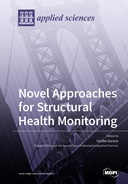Explore

Novel Approaches for Structural Health Monitoring
0 Ungluers have
Faved this Work
Login to Fave
The thirty-plus years of progress in the field of structural health monitoring (SHM) have left a paramount impact on our everyday lives. Be it for the monitoring of fixed- and rotary-wing aircrafts, for the preservation of the cultural and architectural heritage, or for the predictive maintenance of long-span bridges or wind farms, SHM has shaped the framework of many engineering fields. Given the current state of quantitative and principled methodologies, it is nowadays possible to rapidly and consistently evaluate the structural safety of industrial machines, modern concrete buildings, historical masonry complexes, etc., to test their capability and to serve their intended purpose. However, old unsolved problematics as well as new challenges exist. Furthermore, unprecedented conditions, such as stricter safety requirements and ageing civil infrastructure, pose new challenges for confrontation. Therefore, this Special Issue gathers the main contributions of academics and practitioners in civil, aerospace, and mechanical engineering to provide a common ground for structural health monitoring in dealing with old and new aspects of this ever-growing research field.
This book is included in DOAB.
Why read this book? Have your say.
You must be logged in to comment.
Rights Information
Are you the author or publisher of this work? If so, you can claim it as yours by registering as an Unglue.it rights holder.Downloads
This work has been downloaded 95 times via unglue.it ebook links.
- 95 - pdf (CC BY) at Unglue.it.
Keywords
- Adamax
- adaptive-passive damping
- Bayesian inference
- bending test
- BOTDR
- Bouc–Wen model
- bridge
- broken rail detection
- categorical cross-entropy
- CFRP sheet
- combined subspace system identification
- covariance-driven stochastic subspace identification (SSI-COV)
- cover delamination
- crack damage detection
- cross-modal strain energy
- damage detection
- damping of vibrations
- data-driven stochastic subspace identification (SSI-DATA)
- deep neural network
- displacement
- dynamic characteristic
- Experiments
- extreme function theory
- Extreme Value Theory
- failure monitoring accuracy
- Fiber optics
- frequency
- full-field reconstruction
- GB-RAR
- generalised extreme distribution
- guided wave ultrasound
- health and structural integrity
- hysteretic system identification
- interfacial de-bonding
- inverse Finite Element Method
- inverse problem
- Machine learning
- masonry structures
- model calibration
- monitoring system
- mooring line
- multisensor array
- n/a
- noise robustness
- non destructive testing
- non-destructive testing
- noncontact remote sensing (NRS)
- nondestructive testing (NDT) method
- optical flow algorithm
- Particle Impact Damper
- peak frequency
- piezoelectric admittance
- piezoelectric impedance
- pipeline
- precise positioning
- prestress force determination
- prestress loss
- prestressed concrete (PC) girder
- PRISMA
- rail
- rail diagnostics
- real-time monitoring
- seismic structural health monitoring
- sensitivity analysis
- sensor optimization
- Shape Sensing
- sigmoid function
- strain distribution characteristics
- Structural health monitoring
- structural health monitoring (SHM)
- submerged floating tunnel
- subspace system identification
- super high-rise building
- Technology, engineering, agriculture
- Technology: general issues
- un-bonded position
- Uncertainty Quantification
- uniaxial automatic cruise acquisition device
- vertical deflection measurement
- vibration-based damage detection
- wheel flat
- “compression–softening” theory
Links
DOI: 10.3390/books978-3-0365-2405-4Editions

